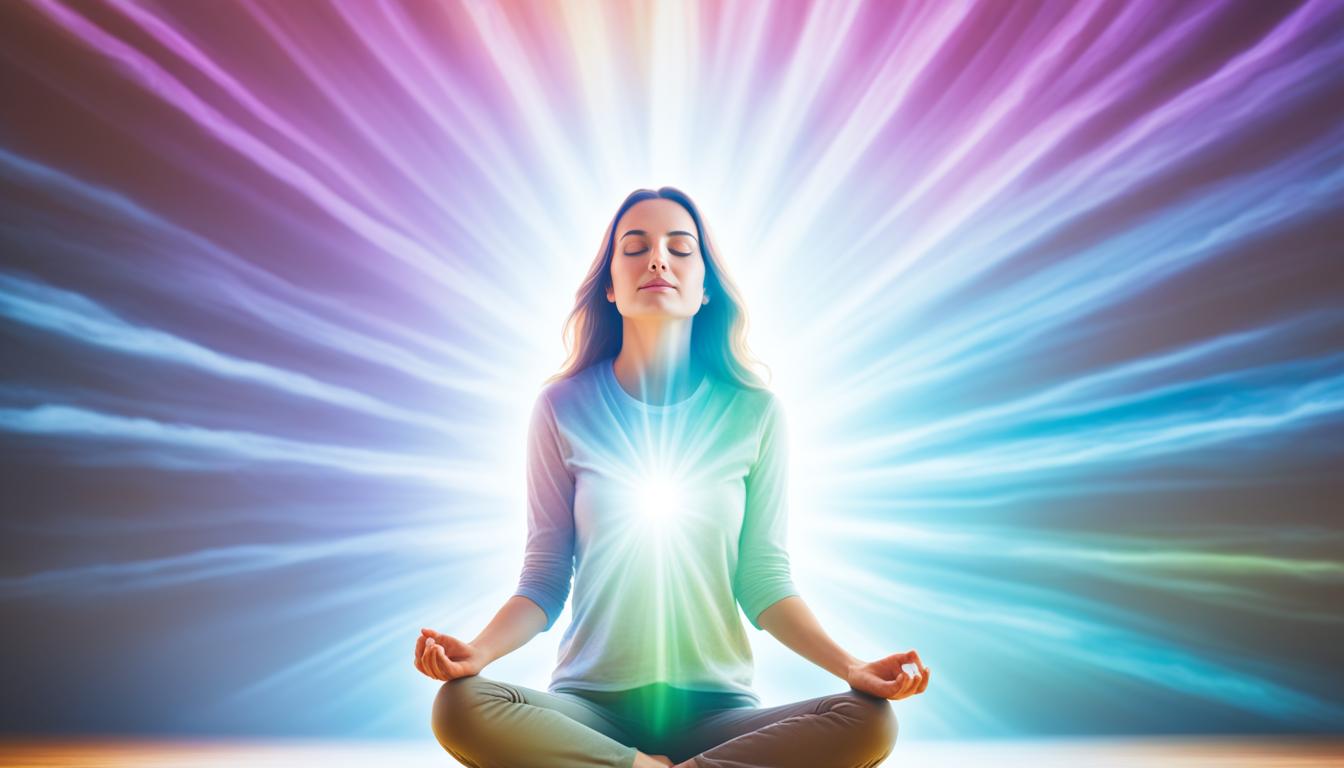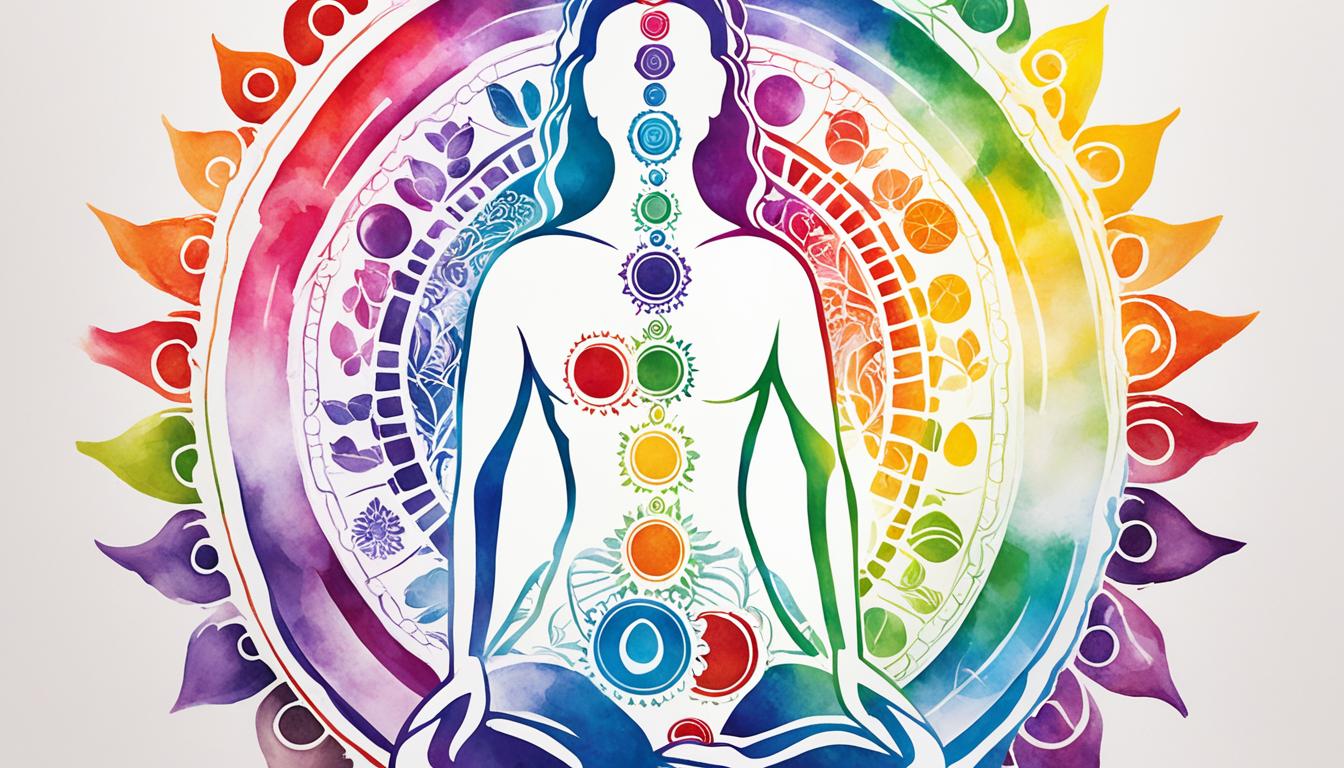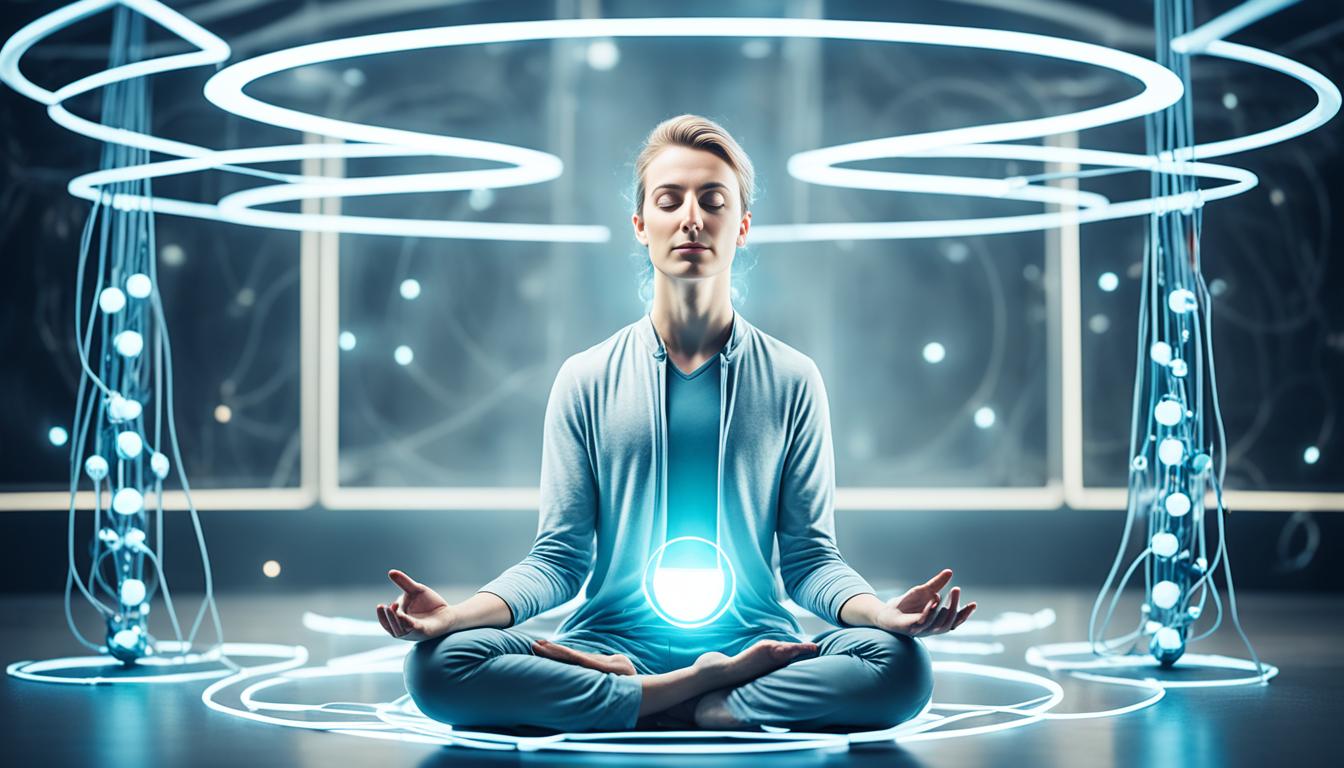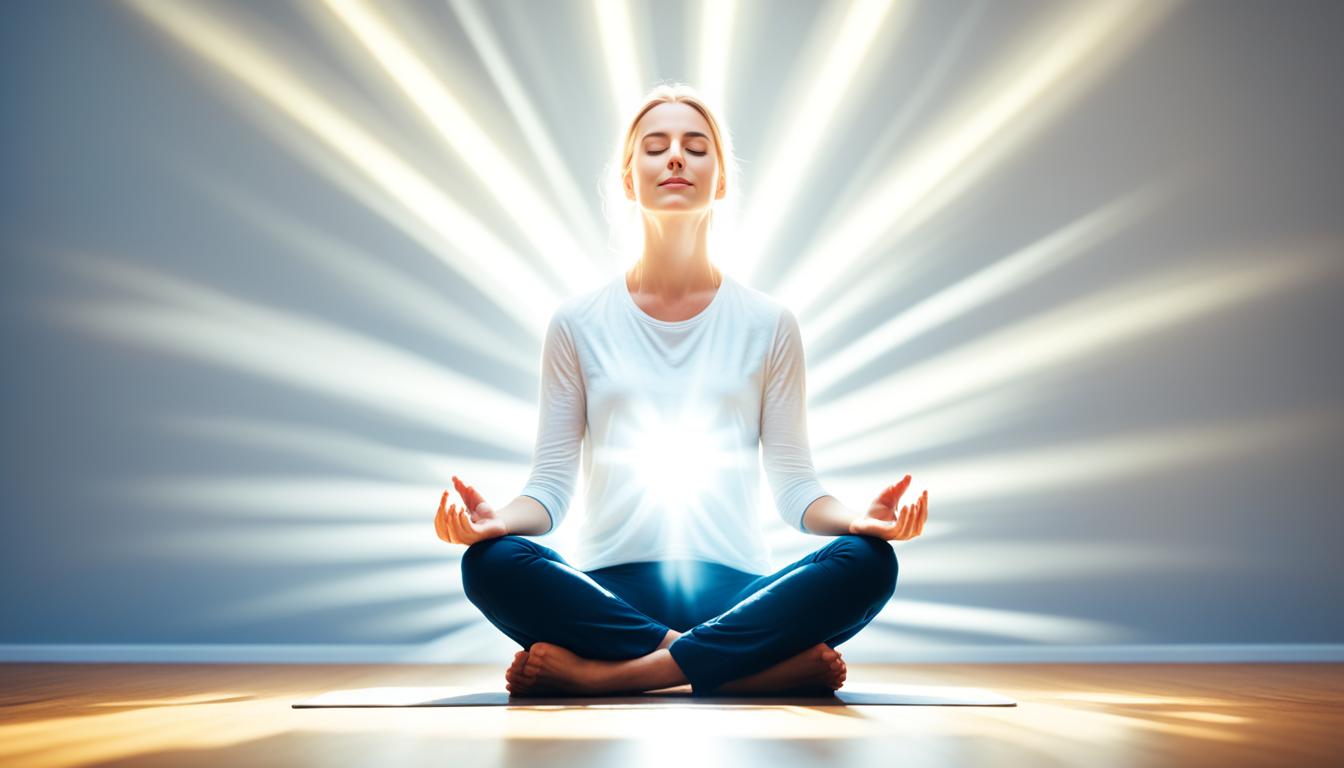Welcome to a journey of tranquility and self-discovery through light meditation. In today’s fast-paced world, finding moments of calmness and inner peace is essential for your overall well-being. Light meditation, with its mindfulness practice, relaxation techniques, and guided meditation, offers a path to achieve mental clarity, relieve stress, and cultivate a sense of calmness.
Imagine a moment of stillness, where the noise and worries of the world fade away, and you are left with a deep sense of peace. Light meditation can help you achieve this serene state by harnessing the power of your mind and connecting with the energy of white light. By incorporating various techniques, you can embark on a transformative journey of self-discovery and inner peace.
In this article, we will explore what light meditation is and its numerous benefits. We will delve into the science behind white light in meditation and the techniques to see and experience it. You will also discover how light meditation can be a powerful tool for manifesting inner peace and explore mindfulness techniques for daily stress relief. Finally, we will examine the role of mindfulness in finding inner peace and provide you with key takeaways to incorporate into your practice.
Key Takeaways:
- Light meditation combines mindfulness, relaxation techniques, and guided meditation to cultivate calmness.
- White light visualization in meditation promotes mental clarity, stress relief, and inner peace.
- Scientific research explores the neurobiological aspects of white light in meditation.
- Techniques like guided meditation, chakra healing, and pineal gland focus can enhance your experience of white light.
- Manifestation triggers and mindfulness techniques align inner peace with your meditation practice.
What is Light Meditation and its Benefits?
Light meditation is a powerful practice that can bring about a profound sense of calmness and inner peace. It involves focusing on and visualizing white light during your meditation sessions. By incorporating relaxation techniques and guided meditation, you can enhance your light meditation practice and experience its transformative power.
One of the key benefits of light meditation is its ability to promote mindfulness. As you direct your attention to the white light, you become fully present in the moment, allowing you to let go of distractions and worries. This practice cultivates a deep sense of awareness and helps you develop mental clarity.
Light meditation is also an effective tool for stress relief. As you immerse yourself in the visualization of white light, you create a space of serenity and tranquility within yourself. This practice helps to reduce stress levels, allowing you to experience a greater sense of calmness.
In addition to promoting mindfulness and stress relief, light meditation can also foster inner peace. By regularly incorporating this practice into your routine, you create an opportunity for self-reflection and introspection. This deep connection with the white light can lead to a profound sense of inner peace and harmony.
By engaging in light meditation, you open yourself up to a world of possibilities for personal growth and transformation. It is a practice that can bring clarity to your mind, relief to your stress, and a deep sense of inner peace to your life. So, embrace the power of light meditation and experience the profound benefits it has to offer.
Incorporating Relaxation Techniques into Your Light Meditation Practice
To enhance your light meditation practice, it’s beneficial to incorporate relaxation techniques into your sessions. These techniques can help you achieve a deeper state of relaxation and increase the effectiveness of your meditation practice.
One relaxation technique you can try is deep breathing. Before you begin your light meditation, take a few moments to focus on your breath. Breathe in deeply and slowly, allowing your abdomen to expand, and then exhale fully, releasing all tension and stress. This simple practice prepares your mind and body for a more relaxed and focused meditation experience.
Another effective relaxation technique is progressive muscle relaxation. Start by tensing and then releasing each muscle group in your body, from your toes to your head. This technique helps release any physical tension you may be holding, allowing you to enter a state of greater relaxation during your light meditation practice.
Remember, the key is to find relaxation techniques that work best for you and complement your light meditation practice. Experiment with different techniques and discover what helps you achieve a deeper state of relaxation and promotes a greater sense of calmness and inner peace.

Continue reading: Understanding the Science of White Light in Meditation
Understanding the Science of White Light in Meditation
The experience of seeing white light during meditation can hold various interpretations. Some believe it signifies enlightenment or spiritual growth, while others connect it to the activation of the pineal gland or the third eye. Scientific research is delving into the neurobiological aspects of this phenomenon, exploring its correlation with changes in brain waves and perception.
The interpretation of white light in meditation is deeply intertwined with spiritual and personal beliefs. It is often viewed as a symbol of enlightenment, representing the journey towards higher states of consciousness and awareness. By focusing on white light during meditation, individuals seek to connect with their deeper selves and attain a heightened level of spiritual growth.
Furthermore, the pineal gland, also known as the “third eye,” has been associated with the perception of white light during meditation. Some theories suggest that the activation of the pineal gland is responsible for experiencing the white light and unlocking spiritual insights.
Scientific research has shed light on the neurobiological processes that occur during meditation and how they relate to the experience of white light. Studies have shown that meditation can induce changes in brain waves, specifically an increase in alpha and theta waves, which are associated with relaxation, deep concentration, and heightened spiritual experiences.
Additionally, the perception of white light during meditation has been linked to alterations in visual processing. Research suggests that this phenomenon may be attributed to the brain’s modulation of sensory information, allowing individuals to perceive a vivid white light that transcends the ordinary visual experience.
“The experience of white light during meditation is a profound and personal encounter, reflecting the intricacies of one’s spiritual journey. Scientific exploration offers valuable insights into the neurobiological underpinnings of this phenomenon, further enriching our understanding of meditation and its potential for spiritual growth and enlightenment.”
Understanding the science behind white light in meditation can deepen your practice and enhance the benefits it brings. By acknowledging the multiple interpretations and scientific research surrounding this phenomenon, you can embrace the transformative potential of white light in your meditation journey.

Techniques to See and Experience White Light in Meditation
Experience the transformative power of white light in your meditation practice with these techniques. By incorporating visualization exercises, guided meditation, and focusing on specific elements like chakra healing or the pineal gland, you can deepen your connection with the white light and enhance your overall meditation experience.
One effective technique to see and experience white light is through visualization exercises. During your meditation, close your eyes and imagine a bright, pure white light surrounding you. Visualize this light permeating every cell of your being, bringing a sense of peace and clarity. With consistent practice, your ability to see and connect with the white light will become more vivid and profound.
Guided meditation is another powerful tool to explore the world of white light. Find guided meditation sessions or recordings that specifically focus on white light meditation. These sessions will provide step-by-step instructions to help you see and experience the beauty and energy of the white light.

Additionally, incorporating chakra healing meditation can enhance your ability to connect with the white light. Each chakra in your body is associated with a specific color, and when balanced and aligned, they can help facilitate the flow of energy and white light. Focus on each chakra during your meditation, visualizing its corresponding color and allowing the white light to cleanse and energize that specific area.
Another approach is to direct your focus towards the pineal gland, often referred to as the “third eye.” This small gland, nestled deep within the brain, is believed to have a connection with spiritual experiences, including the visualization of white light. While in meditation, gently bring your awareness to the area of your forehead, between your eyebrows. Visualize the white light radiating from that point, expanding your perception and connecting you with a higher consciousness.
Remember, consistency and a willingness to let go of expectations are key in your journey to experience the power of white light in meditation. Embrace these techniques, explore different practices, and allow the white light to guide you towards a deeper sense of peace, clarity, and spiritual growth.
Manifestation Triggers: Aligning Inner Peace with Meditation
Manifestation triggers serve as powerful focal points during meditation, allowing you to align your thoughts, intentions, and desires with the universe. By incorporating visualization and mental imagery into your meditation practice, you can enhance the manifestation of inner peace in your life.
Imagine creating a mental sanctuary within your mind, a tranquil space where you can visualize and manifest peaceful moments. As you immerse yourself in this serene imagery, you align your energy with the vibrations of calmness and tranquility.
Another effective technique for aligning inner peace with your meditation practice is incorporating gratitude. As you enter a state of deep relaxation, visualize the things you are grateful for in your life. Feel the genuine appreciation for these blessings, allowing your heart to overflow with gratitude.
Through these manifestation triggers, you strengthen the connection between your meditation practice and the manifestation of inner peace. By regularly incorporating visualization, mental imagery, and gratitude practices into your meditation routine, you create a powerful synergy that brings forth a profound sense of peace and harmony.

Embracing the Power of Manifestation Triggers
When you align your inner peace with meditation, you tap into the transformative power of manifestation triggers. As you cultivate a deeper connection with your desires and intentions, you set in motion the manifestation of your inner peace. Through consistent practice and an open heart, you can unlock the unlimited potential within yourself and create a life filled with serenity, joy, and fulfillment.
Mindfulness Techniques for Daily Stress Relief and Inner Peace
When it comes to finding daily stress relief and cultivating inner peace, mindfulness techniques are powerful tools that can make a significant difference in your well-being. By incorporating these techniques into your daily routine, you can shift your focus from worries to the present moment, promoting relaxation, self-awareness, and a sense of interconnectedness.
One of the fundamental mindfulness practices is mindful breathing. Taking a few moments each day to focus on your breath can help you become present and anchor yourself in the present moment. Simply observe your breath as it flows in and out, letting go of any tension or distractions.
Observing the present moment is another essential mindfulness technique. Take the time to notice the sensations in your body, the sounds around you, and the thoughts and emotions that arise. Cultivating non-judgmental awareness of the present moment can help you detach from stressors and create a space of calmness.
A body scan meditation is a practice that involves systematically bringing attention to different parts of your body, starting from the top of your head and moving down to your toes. This technique promotes relaxation and helps you develop a deeper connection with your body.
Incorporating mindful eating into your daily routine can also contribute to daily stress relief and inner peace. Take the time to savor each bite, paying attention to the taste, texture, and aroma of your food. Mindful eating allows you to develop a healthier relationship with food and fosters a sense of gratitude for nourishment.
Cultivating gratitude is an essential mindfulness practice that can profoundly impact your well-being. Take a few moments each day to reflect on the things you are grateful for and express gratitude for the blessings in your life. This practice shifts your focus from what is lacking to what is abundant, fostering a sense of contentment and inner peace.

By incorporating these mindfulness techniques into your daily life, you can experience a profound shift in your well-being. Embrace the power of mindful breathing, observation, body scan meditation, mindful eating, and gratitude to find daily stress relief and cultivate inner peace.
The Role of Mindfulness in Finding Inner Peace
The Role of Mindfulness in Finding Inner Peace
Mindfulness plays a vital role in finding inner peace amidst the challenges of modern life. By practicing mindfulness, you can develop resilience, clarity, and a greater sense of peace.
Setting boundaries with technology is essential in creating a conducive environment for mindfulness. Limiting screen time, taking digital detoxes, and establishing tech-free zones allow you to focus on the present moment and reduce distractions. Embracing technology mindfully enables you to use it as a tool for growth and connection rather than as a source of stress.

Incorporating loving-kindness meditation in your mindfulness practice can deepen your sense of inner peace. This form of meditation involves sending compassion and well-wishes to yourself and others. By cultivating feelings of love, kindness, and empathy towards yourself and the world, you create a nurturing space for inner peace to flourish.
Remember that mindfulness is a continual journey, rather than a destination. Embrace each moment with awareness and non-judgment, allowing yourself to fully experience life. Through consistent practice and the integration of mindfulness into your daily routine, you can navigate stress, find solace, and cultivate long-lasting inner peace.
Conclusion
Light meditation is a profound practice that has the potential to transform your life. By incorporating various techniques and mindfulness practices, you can harness the power of meditation to cultivate inner peace, reduce stress, and experience mental clarity.
Through light meditation, you can tap into a state of calmness and tranquility, allowing yourself to let go of worries and find solace within. The relaxation techniques and guided meditation involved in this practice can help you release tension and embrace a sense of calmness.
By committing to the journey of light meditation, you open yourself up to a world of possibilities. Discover the transformative power it holds for your well-being and sense of inner peace. Embrace the practice wholeheartedly and witness the positive changes it brings to your mind, body, and spirit.
FAQ
What is light meditation?
Light meditation is a mindfulness practice that involves focusing on and visualizing white light during your meditation practice. It can promote relaxation, reduce stress, improve mental clarity, and cultivate a sense of calmness and inner peace.
How can light meditation benefit me?
Light meditation offers several benefits, including promoting mindfulness, reducing stress levels, improving mental clarity, and fostering a sense of inner peace. It can help you achieve a state of calmness and well-being in your life.
What is the science behind white light in meditation?
The experience of seeing white light during meditation has different interpretations. Some believe it represents enlightenment or spiritual growth, while others connect it to the activation of the pineal gland or the third eye. Scientific research is exploring the neurobiological aspects of this phenomenon, linking it to changes in brain waves and perception.
How can I see and experience white light in meditation?
There are several techniques you can use to see and experience white light during meditation. Visualization exercises, such as guided meditation with a focus on white light, can help you develop the ability to see it more clearly. Exploring practices like chakra healing meditation or focusing on the pineal gland can also enhance your connection with the white light.
What are manifestation triggers?
Manifestation triggers are focal points during meditation that align your thoughts, intentions, and desires with the universe. By incorporating visualization and mental imagery into your meditation practice, you can enhance the manifestation of inner peace. Creating a mental sanctuary, manifesting peaceful moments, and incorporating gratitude practices are effective techniques for aligning inner peace with your meditation practice.
What are some mindfulness techniques for daily stress relief and inner peace?
Mindfulness techniques are powerful tools for finding daily stress relief and cultivating inner peace. Engaging in mindful breathing, observing the present moment, practicing body scan meditation, mindful eating, and gratitude can help you shift your focus from worries to the present moment. These techniques promote relaxation, self-awareness, and a sense of interconnectedness, leading to enhanced well-being and inner peace.
How does mindfulness play a role in finding inner peace?
Mindfulness plays a vital role in finding inner peace amidst the challenges of modern life. By practicing mindfulness, you can develop resilience, clarity, and a greater sense of peace. Setting boundaries with technology, incorporating loving-kindness meditation, and embracing the practice as a continual journey can help you navigate stress and cultivate long-lasting inner peace.
How can light meditation help me achieve inner peace?
Light meditation is a powerful practice that can bring about profound changes in your life. By incorporating various techniques and mindfulness practices, such as relaxation techniques, guided meditation, and visualization exercises, you can harness the power of meditation to cultivate inner peace, reduce stress, and experience mental clarity. It provides a pathway to achieving a state of calmness and well-being in your life.
Source Links
- https://enhancedapp.io/seeing-white-light-in-meditation-a-guide-to-harness-the-power-of-white-light/
- https://fastercapital.com/content/Meditation-Practices–Aligning-with-Manifestation-Triggers-for-Inner-Peace.html
- https://medium.com/@aymanmouselly/mastering-mindfulness-7-practical-techniques-for-daily-stress-relief-and-inner-peace-8e66421687d6


